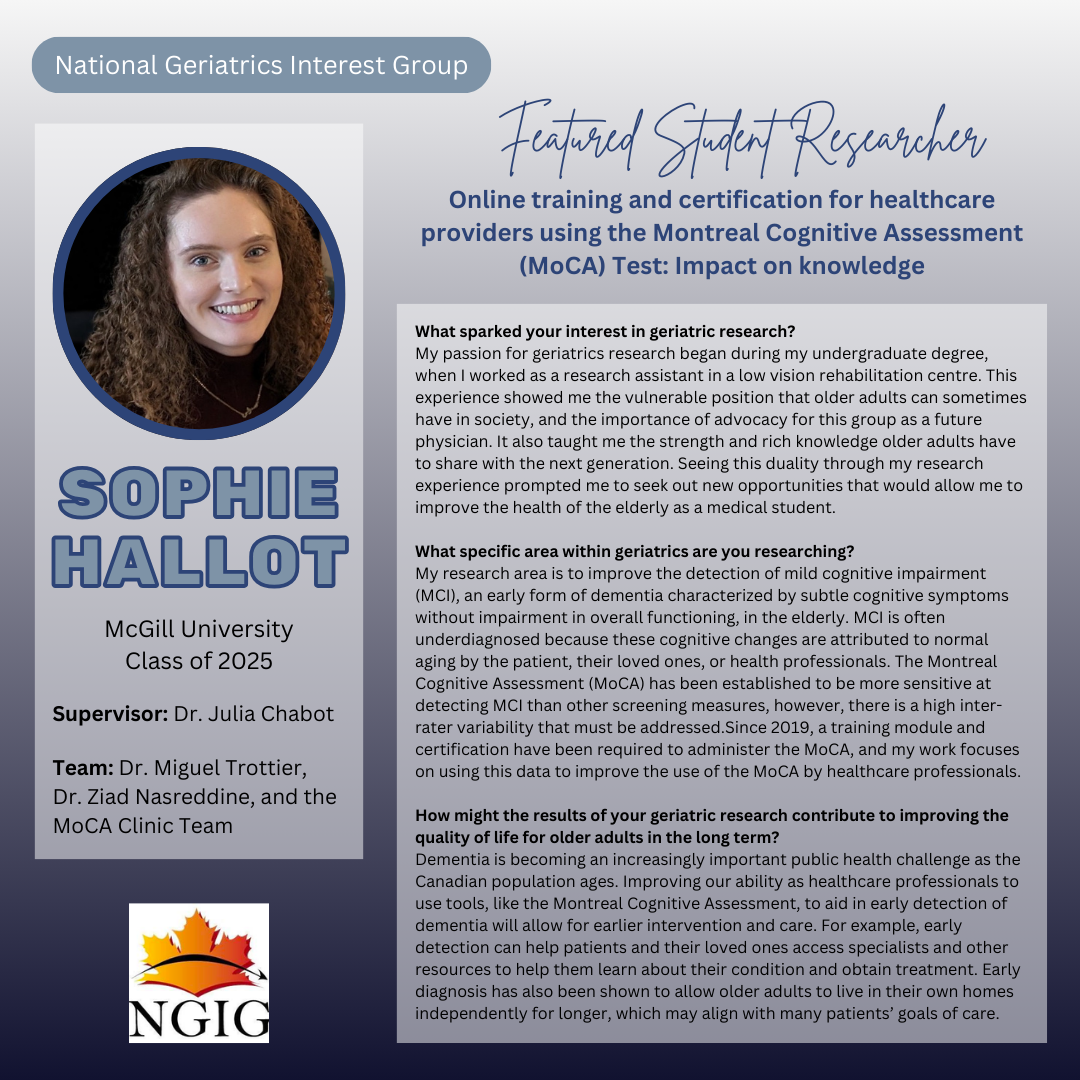Welcome to the CGS Student Site
This page will be a source of news, upcoming conferences and important events, so check back often!

The 10th Annual NGIG Publication is now live! The theme for this year is "Creativity in Care".
Highlighted Research in Geriatric Medicine
Title: The global prevalence of and risk factors for fear of falling among older adults:
Authors: Wanhong Xiong1,2, Dan Wang1, Wei Ren1, Xinyi Liu1, Renhui Wen1 and Yu Luo1*
BMC Geriatr 24, 321 (2024). https://doi.org/10.1186/s12877-024-04882-w
A systematic review and meta-analysis were conducted to investigate the global prevalence of fear of falling (FOF) among older adults (≥60 years old) and to explore its associated risk factors. A total of 153 studies involving 200,033 participants from 38 countries were included in the analysis.
The global prevalence of FOF was found to be 49.60%, with a wide range of prevalence rates ranging from 6.96% to 90.34%. Subgroup analysis revealed higher prevalence rates in developing countries (53.40%) compared to developed countries (46.7%), and in hospitalized older patients (52.20%) compared to community-dwelling older adults (48.40%). Additionally, 28 risk factors were identified to be significantly associated with FOF, including demographic characteristics, physical function, chronic diseases, and mental health problems.These findings underscore the importance of addressing FOF, particularly in developing countries and among hospitalized older patients. Policy-makers, healthcare providers, and government officials are encouraged to consider these risk factors when formulating intervention measures aimed at reducing FOF and improving the well-being of older adults.
Submitted by Dr. Kedar K. V. Mate (BSc PT, MSc, PhD), a second-year medical student from McGill University. Summary by Dr. Mate and NGIG VP Research, Rachael Donnelly.
Title: Development of a Frailty Ladder Using Rasch Analysis: If the Shoe Fits
Authors: Mayo NE, Aubertin-Leheudre M, Mate KKV, Figueiredo S, Fiore JF Jr, Auais M, Scott SC, Morais JA. Can
Geriatr J. 2023 Mar 1;26(1):133-143. doi: 10.5770/cgj.26.601.
The Canadian population is ageing and is projected to surpass 4.7 million by 2036. With increasing longevity, more and more people are living with multiple comorbidities that predispose them to frailty. The most widely accepted and referenced definition is the one by Fried and colleagues that frailty phenotype (FP) assesses physical frailty through five criteria: unintentional weight loss; weakness or poor handgrip strength; self-reported exhaustion; slow walking speed; and low physical activity (1) .
This paper presents frailty as four converging situations in an older person: systemic illness which is the accumulation of acute and chronic illness from those on the list for accumulation of deficits, poor genes, poor lifestyle, and poor environment (2-4) . When these converge with ageing, they create the “perfect storm” that is frailty. As a syndrome or phenotype, it is an entity that can be classified and the most common way to classify someone as frail or not is if they manifest 3 of 5 physical criteria: slowness, weakness, exhaustion, inactivity, and weight loss. This approach renders frailty as a unidimensional, formative construct that is quantified by counting these physical manifestations.
In this paper, we approached frailty as a health state experienced by older persons (caused by the perfect storm), a latent construct, that can be measured based theoretically on how a person functions: physically, cognitively, emotionally, and socially. The paper uses Rasch Measurement Theory, a statistical method based on the probability of a person endorsing a test item) depending on both the person's ability and the difficulty of the item (5) . The model places both individuals and items on the same measurement scale, allowing for meaningful comparisons. Using Rasch analysis, frailty is viewed using the image below. The article also proposes a new definition of frailty as “A dynamic health state experienced by an older person who, in the face of systemic illness or health threat, fails to maintain physiological and functional benchmarks expected for age and sex.”
1. Fried LP, Tangen CM, Walston J, Newman AB, Hirsch C, Gottdiener J, et al. Frailty in older adults: evidence for a phenotype. The journals of gerontology Series A, Biological sciences and medical sciences. 2001;56(3):M146-56.
2. Andrew MK, Mitnitski AB, Rockwood K. Social vulnerability, frailty and mortality in elderly people. PloS one. 2008;3(5):e2232.
3. Brinkman S, Voortman T, Kiefte-de Jong JC, van Rooij FJ, Ikram MA, Rivadeneira F, et al. The association between lifestyle and overall health, using the frailty index. Archives of gerontology and geriatrics. 2018;76:85-91.
4. Livshits G, Ni Lochlainn M, Malkin I, Bowyer R, Verdi S, Steves CJ, et al. Shared genetic influence on frailty and chronic widespread pain: a study from TwinsUK. Age and ageing. 2018;47(1):119-25.
5. Rasch G. Probabilistic models for some intelligence and attainment tests: ERIC; 1993.
NGIG Featured Student Researchers 2024
Geriatrics research is vital to continue improving the care of Canada's aging population. Check out the featured NGIG Student Researchers below that NGIG's VP Research, Rachael Donnelly, had the opportunity to interview. If you would like your research featured or have something interesting to share, please reach out to Rachael Donnelly at ngigvpresearch@gmail.com.
|  |

